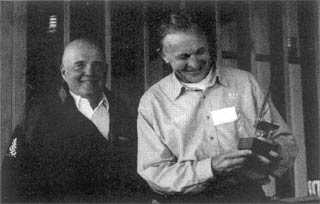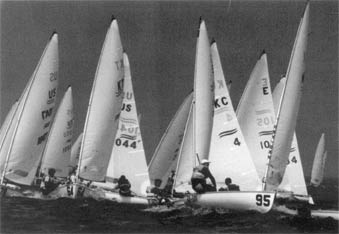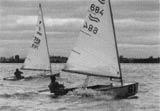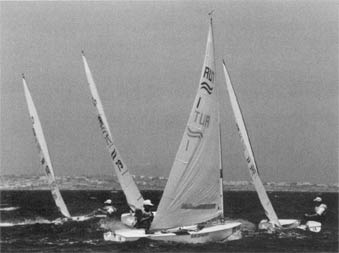1994
After twice losing the Gold Cup on the final day,
Fredrik Loof finally fixed it and won it in Parnu,
Estonia, in what was described as one of the best
Gold Cups ever. The Olympic Champion Jose Maria
van der Ploeg won the Europeans in Turkey. The experimentation
on courses and formats continued. The carbon mast
debate also continued with many fearing the lack
of availability and the cost of the new masts.
The Devoti Finn was announced to be the supplied
hull at the 1996 Olympics in Savannah.
The IFA development Finn was widely used all over
Europe by sailors from Ukraine, New Zealand and
Japan before being shipped to Australia for the
1995 Gold Cup. This provided developing sailors
the opportunity to sail a Finn and compete at the
highest level without the expense of transporting
a boat. |
 |
At
the 1997 AGM, ISAF President Paul Henderson
made a presentation to retiring IFA President
Gerardo Seeliger after 20 years service,
Treasurer 1977-1981, President 1981-1997
|
|
1995
The season started off with the Gold Cup in Melbourne,
Australia, the first Gold Cup in that region for 15 years.
Hans Spitzauer won a very close series after the last
race could not be started with the time limit. Almost
everyone was now using the carbon masts, with Spitzauer
using one of the first 'wing' masts that he had developed.
At the AGM later in the year, the Technical Committee
was directed to come up with recommendations to ensure
that a financial arms races does not develop.
Many Finn sailors were involved in the America's
Cup in the US. Russell Coutts, the 1980 Finn Olympic
Gold Medalist won it convincingly.
|
On 25 April 1995, long time former IFA secretary
Nikos Kouklelis died.
On Lake Balaton, Jose Maria van der Ploeg successfully
defended his European Championship title. One of
the favourites for the 1996 Olympics, Fredrik Loof
won the Pre-Olympics in Savannah.
1996
For the first time ever the Finn Gold Cup and the
Finn World Masters were held together at the same
venue and at the same time. The idea was to show
everyone how big the Finn class really was. 192
Finns came together in May at La Rochelle, France
for the biggest Finn event so far. Philippe Presti
won his second Gold Cup and gained qualification
for the Olympic regatta
in the summer. Roland Balthasar won the equally competitive,
if a bit older, Masters fleet. |
 |
|
Just before the Olympics, Jose Maria van der Ploeg won
his third consecutive European title in fine form, becoming
in the process only the third Finn sailor to win a major
Finn regatta three times in succession. (The others being
Paul Elvstrom, Olympics: 1952, 1956, 1960 and Jorg Bruder,
Gold Cup: 1970,1971,1972.) |
The four favourites for an Olympic Medal didn't
win anything. Just after winning the Junior European
title for the second time, Mateusz Kusznierewicz
(Poland) won the Gold medal with a race to spare.
The other two medal winners, Sebastien Godefroid
(Belgium) and Roy Heiner (Holland) were ranked by
coaches outside the top ten.
The Finn had to fight off perhaps its strongest
challenge yet to Olympic Status. Many saw the Laser
as a threat, but many also saw it as good for sailing,
offering top quality singlehanded racing for helms
of a
|
 |
|
different
weight requirement to that of the Finn. At the ISAF (formerly
IYRU) conference in Brighton, in the UK, the Finn argument
won the day and the Finn was selected again for the 2000
Olympics in Sydney
1997
Luca Devoti had never won a major event, despite being
one of the most experienced sailors in the Finn fleet,
but in 1997 he won the Europeans in Split, Croatia. Fredrik
Loof won the Gold Cup for the second time, this time in
Gdansk, Poland, winning the title from Luca in the final
race. 1981 Gold Cup winner Wolfgang Gerz won the Masters
event.
A 'rookie' place was introduced for the Gold Cup and Europeans
for any sailor who had never before sailed in one of these
events.
At the AGM in Gdansk, Gerardo Seeliger, who had been President
of the IFA since 1981, retired and Philippe Rogge (whose
father Jacques had been IFA President immediately before
Gerardo) became the tenth President of the IFA. Gerardo
was then presented with a model Finn by ISAF President
Paul Henderson. The first thing Philippe Rogge did as
the new IFA President was to appoint Gerardo as IFA President
of Honour.
Also retiring at that AGM was Josje Dominicus after 6
years as Executive Director and 7 years as FINNFARE Editor.
Josje's replacement as Executive Director was Sarah Kingston,
while Robert Deaves who was the British Finn Secretary
took over as FINNFARE Editor. |
|
|
welcomed
by yacht clubs around the world, so the Gold Cup was superbly
organised in very short time in Athens, Greece.
After dominating most races early in the year, Sebastien
Godefroid won the Europeans without winning a single race.
The 1996 Olympic Gold Medal winner Mateusz Kusznierewicz
won the Gold Cup. The last race in both these events was
cancelled due to lack of consistent wind. All year sailors
were experimenting with hard cloth such as kevlar, mylar
and vectran. |
 |
Sails
made of these materials were gradually gaining
success and numbers during the season.
After
being founded in 1961 by Fred Miller in the US,
1998 saw FINNFARE celebrate its 100th issue with
a special issue with contributions from many of
the sailors and personalities who had been part
of its history.
|
|
1999
The 50th Year of the Finn started with the Gold
Cup in Melbourne once again, with a massive combined
World Championships in Port Philip together with
13 other classes. Fredrik Loof won the Gold Cup
for the third time and became the most successful
Gold Cup participant of all time, having scored
top three in the last seven Gold Cups.
It was decided to publish a new book on the history
of the Finn, to bring the material in Peter Mohilla's
FINNOG up to date.
Summary
This is the remarkable history of the Finn. For
50 years the Finn has remained the leading singlehander
in yachting and hopefully will continue so in the
future. In all these years the pivotal issue was
to keep the boat modern and at the same time not
to outclass the existing hulls. Changes were necessary,
but the people in charge had to agree on the proper
pace of development. Inevitably different characters
had different opinions.
|
 |
There
was quite a bit of controversy, but in total the
history of the Finn Class was peaceful and productive.
In this class everybody has enough trouble to negotiate
the boat on the water. So you are glad if you have
friends when returning to the harbour to get your
craft out of the water. Studying the past of the
Finn, it can be expected for the future, that this
boat remains the most athletic, elite-conscious,
rewarding, and the most Olympic class you can ask
for. |
|
|